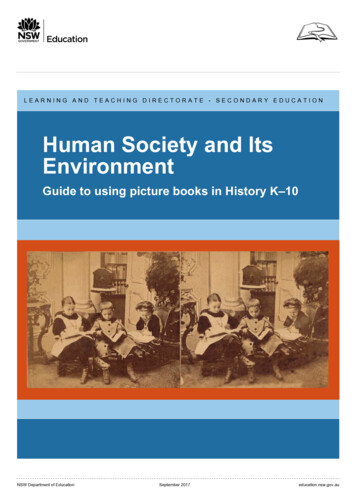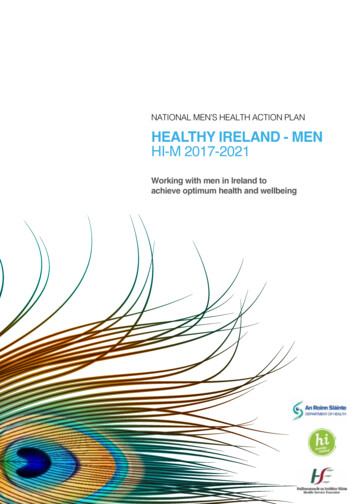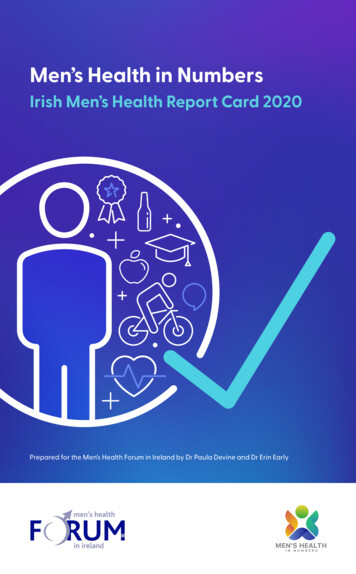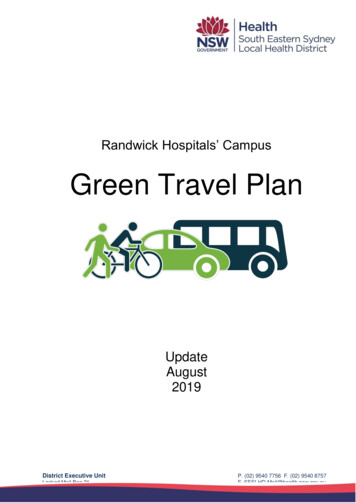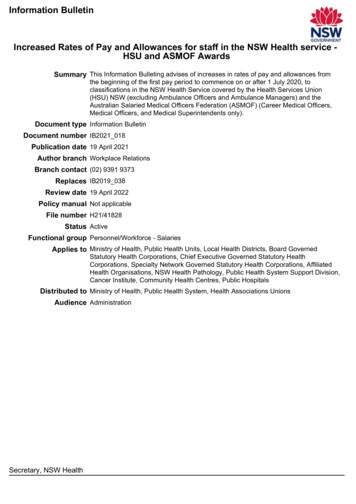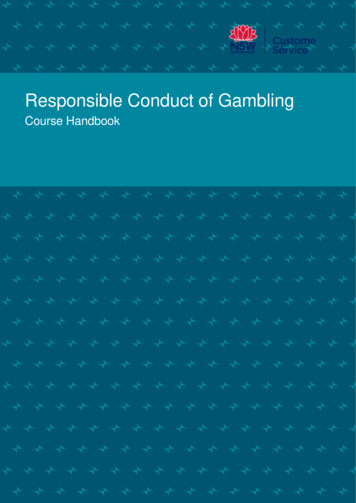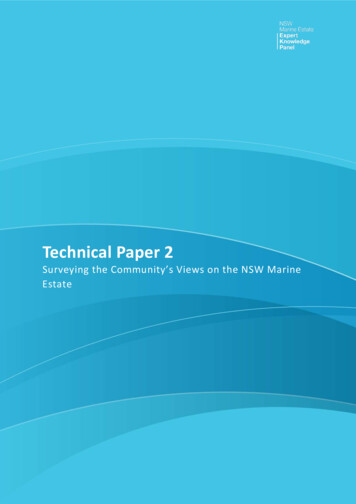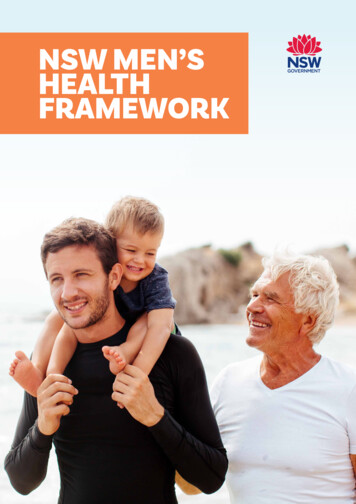
Transcription
NSW MEN’SHEALTHFRAMEWORK
A message from theMinister for HealthMaintaining a healthybody and mind meansthat men and boyscan make the most oftheir lives. Supportingthe health of all menand boys in NSW is animportant part of theNSW Government’scommitment to keeppeople healthy.Men in NSW live longer than almost anywhere else inthe world. However, health risks and health outcomesare not equal between men and women. A boy borntoday can expect to live four years less than a girlborn at the same time.Men face higher rates of avoidable and prematuredeath due to coronary heart disease, cancer,diabetes, suicide and injuries. There are also distinctgroups of men who are at risk of poorer healthoutcomes. Different life stages also signal thepotential for poorer health.Almost two decades ago, NSW was one of thefirst jurisdictions in the world to take the lead inacknowledging the health needs of men, with thelaunch of the Moving Forward in Men’s Health policy.Since then, NSW Health has worked with key partnersto deliver a wide range of research, innovativeservices, resources and awareness raising aboutmen’s health.The NSW Ministry of Health commissioned Urbis to create this reportSHPN: (HSP) 170616ISBN: 978-1-76000-756-0NSW MEN’S HEALTH FRAMEWORKPAGE 2Our partners at all levels of government, as well asin the non-government and community sectors,continue to play an important role in empoweringmen to look after their health.The NSW Men’s Health Framework has beendeveloped in collaboration with key stakeholders.It provides the latest evidence on the most prevalenthealth issues for men and boys, as well as whichgroups are most at risk.The Framework captures NSW Health’s currentcommitment to these health issues and highlightsfurther work to do to improve health outcomes infour key areas in the coming years.We all have a part to play to support those menaround us whose health and wellbeing we caninfluence for the better.Hon Brad Hazzard MPMinister for HealthMinister for Medical Research
ContentsIntroduction4 Framework at a glance 6Snapshot of men’s health and wellbeing 7Developing this Framework 8Guiding principles 10Priority populations 1618Priority health area 1: Mental health and wellbeing Priority health area 2: Cancer22 Priority health area 3: Healthy living and chronic diseases 26 30Priority health area 4: Sexually Transmissible InfectionsImplementing and monitoring this Framework 34References 36NSW MEN’S HEALTH FRAMEWORKPAGE 3
IntroductionMany Australian men experience poor healthoutcomes across a variety of measures, includingrates of overweight and obesity, diabetes or highblood glucose levels, Sexually Transmissible Infections(STI), and mental health and wellbeing. Reflecting thediversity that exists among men, differential healthoutcomes are also experienced by groups of menand men at different life stages. As a result, there iscontinued interest and investment in improving boys’and men’s health and wellbeing across NSW Health,among its partners, and in the community morebroadly. This includes a range of initiatives that seekto address boys’ and men’s needs and preferences,and empower them to play a more active role in theirhealth.Recognising the importance of statewide leadershipfor improving men’s health, in 1999 NSW Health putforward a pioneering policy Moving Forward in Men’sHealth.1 The NSW Men’s Health Plan 2009-20122 thenbuilt on the achievements of this policy. The Plan seta clear vision in which all men in NSW ‘have access toquality health services, information and the supportthey need to achieve and maintain the highestpossible levels of health and wellbeing.’3NSW Health’s ongoing commitment to improvehealth and wellbeing outcomes for boys, youngmales and men is evidenced by this NSW Men’sHealth Framework. The Framework profiles workcurrently undertaken by NSW Health and recognisesthe significant role its partners play in support ofthis work, including a range of non-government andcommunity managed organisations.NSW MEN’S HEALTH FRAMEWORKPAGE 4Based on the existing evidence and commitmentsby NSW Health, as well as consultation with a rangeof stakeholders, four areas were agreed to be healthpriorities for men. These priorities build on previousmale health policies and take into considerationcurrent state and national investments to improvethe health and wellbeing of boys and men. The fourpriority health areas are: mental health and wellbeingcancerhealthy living and chronic diseasesSexually Transmissible Infections (STI).Under these areas, the Framework presents: evidence of issues specific to men a summary of ways in which NSW Health andpartners are responding to these issues suggestions to guide further work priority male populations and life stages.The Framework is underpinned by five guidingprinciples that seek to enable improvements in men’shealth and wellbeing. These principles recognise thesocial determinants of health, including the broadrange of ‘political, social, economic and culturalforces’4 that influence the health outcomes of menin NSW. The principles also acknowledge the diversitythat exists between men, as well as the distinct healthissues experienced by boys and men across theirlifespan.The Framework will act as a reference document andalso guide the continuing actions of Ministry branches,local health districts, and other health agencies whenconsidering the key health and wellbeing needs ofboys and men. These organisations can use theFramework for planning, delivery, and evaluation ofrelevant activities.
NSW MEN’S HEALTH FRAMEWORKPAGE 5
Framework at a glanceVision:Optimal health and wellbeing outcomesfor the diversity of boys and men in NSWTo achieve our vision, what further work can be doneMental health andwellbeingCancerEncourage help-seekingbehavioursReduce high-riskbehavioursFocus efforts onpreventive healthPromote earlyintervention andpreventionIncrease early detection,including throughpromotion of the NationalBowel Cancer ScreeningProgramTarget efforts towardsgroups of men withinhigh-risk populationgroupsReduce stigma attachedto mental ill-health andservice accessTarget vulnerable groupsand men during periodsof elevated riskDeliver ‘male friendly’servicesTarget groups of menwho have poorer canceroutcomesImprove support for menand boys with cancerHealthy livingand chronic diseaseDeliver a genderedapproach to care andhealth promotionPromote integration andcontinuity of careSexually TransmissibleInfectionsDeliver culturallyappropriate preventionprogramsSustain the central roleof condoms in preventingthe transmission of STIsand increase access topre-exposure prophylaxisfor HIVIncrease comprehensiveSTI and HIV screeningFocus on outreachactivitiesSupport evidence-basedactivities for reducingincidence of violenceamong menPriority populationsYoung menMen from rural and regional areasAboriginal and Torres Strait Islander menGay, bisexual and transgender men, and intersexpeopleMen from low socio-economic backgroundsMen from migrant and culturally and linguisticallydiverse backgroundsMen and young men in the criminal justicesystem and after releaseNSW MEN’S HEALTH FRAMEWORKPAGE 6Guiding principlesThe Framework:12345Encourages a holistic view of men’s health andwellbeingSeeks to achieve health equity among andbetween groups of menRecognises the importance of a life courseapproachEmpowers men to play an active role in theirhealth, particularly regarding preventive healthPromotes improved access and engagement inhealth services and programs for all men
Snapshot of men’s health and wellbeing in NSW8185yearsyears In 2015, men in NSW were expected to live four yearsless than women, with the average life expectancybeing 81 years for men, and 85 years for women.510%In 2016 in NSW, diabetes or high blood glucosewas more prevalent in adult men (10%) than inadult women (8%).7In 2016, the rate of death from intentional self-harmwas three times higher in Australian men than women.667%In 2015-16, men in NSW represented67% of all drug and alcohol completedtreatment episodes.8In 2015, the death rate from suicide in NSW was aroundthree times higher in males than females. 16 deaths per100,000 population in males, compared to 5.1 deathsper 100,000 in females.961%61% of adult men in NSWwere overweight or obesein 2016, compared to46% of women.10Across 2014-15, menin Australia were lesslikely to have consulteda General Practitionerin the previous 12months (78%) thanwomen (88%).1192% 19%In NSW in 2016, 92%of newly diagnosedHIV notificationswere men.12Rates of smoking in 2016were higher in men in NSW(19%) than women (12%).13NSW MEN’S HEALTH FRAMEWORKPAGE 7
Developing thisFrameworkWhat did theconsultationshighlight?Framework development wasinformed by research andevidence.Key activities included: a knowledge and data review a stakeholder consultation withNSW Health staff, includingrepresentatives from Ministrybranches, local health districts,and Specialty Health Networks interviews with men’s healthexperts and representativesfrom non-governmentorganisations a survey of representativesfrom NSW Health, men’s healthexperts, and representativesfrom community and nongovernment organisationsinvolved in providing healthservices targeted at men.Efforts are required to increase boys’ andmen’s access to services across NSW,including ensuring that existing servicesare ‘male-friendly’ and respond to theirneeds and preferences for care.There was strong support for outreachactivities and the importance of bringinghealth services to men, such as theAustralian Men’s Shed movement.Population groups of men were identifiedas being particularly at risk of poorerhealth outcomes. Those commonly citedincluded Aboriginal men*, gay, bisexualor transgender men and intersex people,men from migrant and culturally andlinguistically diverse backgrounds,and men in prison and juvenile justicesettings.There was wide support for the need toprioritise the health issues identified inthis Framework, with mental health andwellbeing receiving the strongest level ofsupport.The Framework should reflect a holisticview of health, acknowledging thatgood health is more than the absence ofdisease.* ‘Aboriginal men’ is used to refer to menfrom Aboriginal and Torres Strait Islanderbackgrounds throughout this Framework.NSW MEN’S HEALTH FRAMEWORKPAGE 8
The Framework should adopt asocial determinants approach tohealth, recognising the wide range ofinfluences that impact on the overallhealth and wellbeing of boys and men.Common determinants cited includedmen’s health literacy, help-seekingbehaviour, and socio-economic status.Recommended approaches forpromoting healthy living and reducingthe impacts and incidence of chronicdiseases include promoting healthyeating, exercise and sports, improvingeducation, targeting groups of menand reaching out to men in differentsettings, such as workplaces.Men experiencing periods of changewere also identified as vulnerableto poorer health outcomes,including social isolation. Periodsof change that were cited includedmen entering a new life stage,starting a family, or retiring fromthe workforce.Recommended approaches forreducing the impacts and incidenceof mental ill-health include ensuringservices are male-centric, targetingefforts to groups most at risk ofmental ill-health, and promotingoutreach, social support andcommunity engagement.There was support for NationalMen’s Health Week, which wasrecognised as an opportunityeach year to raise awareness ofmen’s health and to promoterelevant campaigns and initiativesacross NSW.Recommended approaches forreducing the impacts and incidenceof cancer among men includeearly-intervention programs, healthscreening (including self-screening),education, preventive health measures,and group support.Existing and future initiativesguided by the Framework shouldbe inclusive of, and supported by,the views and experiences of menin NSW.Recommended approaches forreducing the impacts and incidenceof STIs include ensuring services areinclusive and available to all men,increasing education, and reducingstigma and discrimination, particularlytowards gay, bisexual, transgendermen and intersex people.NSW MEN’S HEALTH FRAMEWORKPAGE 9
Guiding principlesThe vision of the NSW Men’s Health Framework is to support and achieveoptimal health and wellbeing outcomes for the diversity of men and boyswho reside in NSW. The focus areas in the Framework are underpinned byfive guiding principles that provide further context and direction on howbest to approach and achieve successful outcomes. These principles arealigned with the priorities identified in the National Male Health Policy14and are reflected in many of the initiatives currently being undertaken byNSW Health and a range of its partners.The NSW Men’sHealth Framework:1Encourages aholistic view ofmen’s health andwellbeing.2Seeks to achievehealth equityamong andbetween groupsof men.4Empowersmen to play anactive role intheir otesimprovedaccess to healthservices forall men.NSW MEN’S HEALTH FRAMEWORKPAGE 103Recognises theimportance ofa life courseapproach.
Guiding principle 1The Framework encourages a holisticview of men’s health and wellbeingThe Framework recognises that biology is only one determinant ofmen’s overall health and wellbeing. In line with a social determinantsapproach, it is now widely recognised that men’s health isinfluenced by a broad range of ‘political, social, economic andcultural forces.’15 These include: socio-economic status and cultural background education and health literacy gender norms and the traditional conceptions of masculinity‘embodied by different groups of men’16 engagement in high-risk activities relationships, including men’s roles as fathers and partners employment status and the nature of men’s work engagement in, and experience of, violence institutional barriers, including men’s engagement with thehealth system.These social determinants of health intersect across a number ofdemographic features,17 leading to health inequities between menand women, as well as between groups of men.NSW MEN’S HEALTH FRAMEWORKPAGE 11
Guiding principle 2The Framework seeks to achieve healthequity among and between groups of menMen are not a homogenous group and as such thereis a need to respond to ‘the diversity that existsamong and between groups of men’.18 This includesdiscrepancies in health outcomes between men,as well as their distinct needs.A 2012 report by the Australian Institute of Health andWelfare found that rates of obesity, tobacco smoking,risky alcohol consumption and hospitalisations forType 2 diabetes increased as men’s geographicalremoteness increased.19 Geographical remotenessalso influenced men’s ability to access health care andservices.20In NSW, the life expectancy for Aboriginal men (71years) was 9 years less than non-Aboriginal men (80years) across 2010-12.21 Over this same period, 31%of Aboriginal men reported high to very high levelsof psychological distress, compared to 10% of nonAboriginal men.22 Importantly, ‘multiple inter-relatedfactors’ contribute to the health disparities betweenAboriginal and non-Aboriginal Australians, including a‘clear relationship’ with their socio-economic status.23NSW MEN’S HEALTH FRAMEWORKPAGE 12These two examples highlight the role that varioussocial determinants play in influencing outcomes.The Framework supports achieving equity in healthoutcomes between groups of men. It has identifiedseveral priority populations and life stages throughout,including: Young menMen from rural and regional areasAboriginal and Torres Strait Islander menGay, bisexual or transgender men, and intersexpeople Men from low socio-economic backgrounds Men from migrant and culturally and linguisticallydiverse backgrounds Men and young men in the criminal justice systemand after release.Other groups of men at risk of poorer health outcomesinclude men in prisons and the juvenile justice system,older men, men experiencing major life events, andmen who are refugees and asylum seekers.
Guiding principle 3The Framework recognises theimportance of a life course approachA life course approach seeks to increase the effectiveness of healthservices and promotion activities by ‘focusing on a healthy start to lifeand targeting the needs of people at critical periods throughout theirlifetime.’24 The Framework recognises that men’s health needs, riskprofile, and behaviours shift across their lifespan. Examples of healthissues that impact men across different stages of their life include:Young MenMiddle adulthoodLate adulthoodOlder men(approx. 12–24 years)(approx. 25–49 years)(approx. 50–64 years)(approx. 65 years & over)Suicide is the leadingcause of deathamong young menin Australia aged15-24 years, withyoung men 2.6 timesmore likely to die bysuicide than youngwomen.25In 2016, 36% ofyoung men aged16–24 in NSW wereoverweight or obese,compared to 30% ofyoung women.26Three quarters ofyoung men aged18–24 years inAustralia exceed thesingle occasion riskguidelines for alcoholconsumption (four ormore drinks at onetime), representingthe age cohort mostlikely to exceed thislimit.27Between 200910 and 2015-16,men aged 25-34years in NSWaccounted for thehighest number ofmethamphetaminerelated emergencydepartmentpresentationscompared to otherage and gendercohorts.28In 2016, alcoholconsumption atlevels posing longterm risk to healthwas highest in menaged 25-34 years(49%), compared tomen of other ages.29Across 2002-16,40% of men aged55–64 years inNSW were notgetting enoughphysical activity asdefined by nationalguidelines for theirage group.30In 2015, men aged55-64 years in NSWwere the secondhighest group ofmen to report highor very high levelsof psychologicaldistress.31Between 2001 and2016, recent use ofany illicit drug nearlydoubled amongmen in their 50sfrom 8% to 15% in2016, and men intheir 60s or olderfrom 4% to 8% in2016.32Men aged 85 andover have the highestrates of suicide acrossAustralia: in 2015, thesuicide rate for thisgroup was 39 per100,000 people. 33The risk of prostatecancer increaseswith age, withthe majority ofcases diagnosed inAustralia occurringin men aged 60–79years.34Men aged 8084 years in NSWhave significantlyhigher rates ofhospitalisationfor coronary heartdisease, 4,524 per100,000 population,than women ofthe same age,2,315 per 100,000population.35NSW MEN’S HEALTH FRAMEWORKPAGE 13
Guiding principle 4The Framework promotes improved accessand engagement in health services andprograms for all menIncreasing access to and engagement with health services has been identified asa key enabler to improved health and wellbeing among men. In 2014, the Men’sHealth Information and Resource Centre developed a series of resource kits forpractitioners working with men, which identified a range of structural and systemicbarriers to men accessing health services.36The resource kits recognise for example, that men do not always feel comfortablein health settings, which can be viewed as ‘predominantly female environments’.37While the evidence was identified to be ‘mixed,’ in some instances a lack ofaccess to male physicians and health professionals can also act as a barrier tomen accessing healthcare.38 It is common for men to express a preference tobe seen by a male health professional when they perceive a health issue to be‘sensitive’, such as issues relating to their sexual health.39 Research suggeststhis is particularly the case for Aboriginal men, as well as some groups frommigrant backgrounds.40 Systemic barriers, such as men’s health literacy and pastexperiences engaging with health professionals, can also influence their access tocare.41Linked to this is a strong focus on the role of outreach activities and theimportance of bringing health services to men. An outreach program commonlycited as an effective means of engaging men in their health is the AustralianMen’s Sheds movement. One qualitative study found that Men’s Sheds provide a‘culturally safe environment’ that can facilitate health education and knowledgesharing.42 Several organisations are also drawing on online and digital technology asa potential means for engaging men particularly, young men, such as ReachOut andheadspace.The Framework acknowledges the importance of addressing barriers to healthservice access and ensuring that services are appropriate for men. It also includes afocus on activities undertaken in both outreach and traditional health settings.NSW MEN’S HEALTH FRAMEWORKPAGE 14
Guiding principle 5The Framework empowers men to playan active role in their health, particularlyregarding preventive healthThe Framework promotes the significant role thatmen themselves can play in improving their healthoutcomes, particularly regarding preventive healthand wellbeing measures. There are several key areasfor improvement, including strategies that respond tomen’s: high levels of smokinglow levels of engagement in health screeningengagement in risky behaviourshigh rates of overweight and obesitylow use of health services, including GeneralPractitioners.The engagement of men has also been identifiedas a key enabler to the Framework’s success. Menshould be involved in implementing the currentcommitments included in the Framework and in thedesign, delivery and evaluation of future initiativestargeted at improving men’s health and wellbeingoutcomes.NSW MEN’S HEALTH FRAMEWORKPAGE 15
PriorityPopulationsAchieving equitable health outcomes for boys and men in NSW will require ongoing support for existingprograms and new initiatives to address observed disparities, including in access to services, within andacross different population groups. Based on evidence and consultation, some of which is included below,the Framework aims to highlight several key groups of men that require continued focus in health.Men from low socio-economic backgrounds I n 2015, there was a five-year gap in theaverage life expectancy between menin the least disadvantaged and mostdisadvantaged quintiles in NSW (84years and 79 years respectively).43 I n 2014, men aged 16 and over in themost disadvantaged quintile in NSWexperienced the highest rates of foodinsecurity, when compared to men inother quintiles.44 M en aged 16 and over in the mostdisadvantaged quintile had the highestrates of diabetes in NSW in 2016 (14%).45Aboriginal and Torres Strait Islander men I n 2015-16, Aboriginal men inNSW experienced higher rates ofhospitalisation due to intentional selfharm (339 per 100,000 population)compared to non-Aboriginal men (99per 100,000 population).46 A cross 2012-16, the notificationrate of hepatitis C diagnoses in theAboriginal population increased by 25%,whereas the rate in the non-Aboriginalpopulation remained stable.47 I n 2015-16, Aboriginal men in NSW werehospitalised for coronary heart diseaseat higher rates than non-Aboriginal men(1,180 compared to 745 per 100,000population respectively).48NSW MEN’S HEALTH FRAMEWORKPAGE 16Men from rural and regional areas I n 2015-16, the rate of hospitalisationsfor coronary heart disease was greatestamong men living in remote and veryremote regions of NSW (1,245 per100,000), when compared to otherregions.49 I n 2016, men aged 16 years and over inouter regional and remote areas of NSW(14%) had higher rates of diabetes orhigh blood glucose than men in majorcities (10%).50 I n 2015, men in outer regional andremote areas of NSW experienced thehighest rates of suicide, when comparedto other regions (16 per 100,000population).51Men and young men in the criminal justicesystem and after release I n 2015, 67% of male prisoners surveyedin the Network Patient Health Survey(NPHS) reported drinking alcohol at alevel considered hazardous in the yearbefore incarceration.52 8 1% of male prisoners surveyed inthe 2015 NPHS identified as currentsmokers.53 4 9% of male prisoners surveyed inthe 2015 NPHS reported receivingpsychiatric care before coming toprison.54
Men from migrant and culturally andlinguistically diverse backgrounds I n 2016, 19% of men in NSW born innon-English speaking countries wereestimated to be smokers.55 I n 2011, 6% of people born overseaswho also spoke a language other thanEnglish at home accessed at leastone MBS-subsidised mental healthrelated service, compared to 11% ofpeople born in Australia who alsospoke English at home.56 S tigma around mental health inculturally and linguistically diversecommunities can act as a barrier tohelp seeking behaviour.57Young men S uicide is the leading cause of deathamong young men in Australia aged15-24.58Gay, bisexual or transgender men,and intersex people L esbian, Gay, Bisexual, Transsexualand Intersex (LGBTI) peopleexperience a 3.5 to 14 times higherrate of suicide attempt than thegeneral population,61 with suiciderates in the LGBTI communityreported to be ‘higher than inany other group in the Australianpopulation.’62 I n 2010, homosexual and bisexualpeople in Australia were more likelyto report weekly risky drinking(27%), compared to heterosexualpeople (16%).63 H IV is most common among gay andhomosexually active men in NSW,accounting for around 80% of newdiagnosis in Australia and NSW eachyear.64 I n 2016, 36% of young men aged 1624 years in NSW were overweight orobese.59 I n NSW in 2016, men aged between 1634 were more likely to report drinkingalcohol at levels posing lifetime riskthan older men.60NSW MEN’S HEALTH FRAMEWORKPAGE 17
Priority health area 1Mental health and wellbeingWhat are the issues?While overall women (22%) have been found to havehigher rates of mental disorders than men (18%),65disparities exist in the specific mental illnessesexperienced by the two groups, with men and groupsof men at high risk of some forms of mental ill-healthand suicide. The 2007 National Survey on MentalHealth and Wellbeing found that ‘while women weremore likely to experience anxiety disorders (18%compared to 11% for men) and affective disorders (7%and 5%), substance use disorders were more commonin men (7% compared to 3% for women).’66 The ratesof suicide continue to be high amongst men. In 2015,the death rate from suicide in NSW was 16 deaths per100,000 population in men and 5 deaths per 100,000in women.67 In this same year, young men aged 15-24years in NSW were more than twice as likely to die bysuicide than young women (13 per 100,000 populationin young men, compared to 6 per 100,000 for youngwomen).68Across NSW, disparities exist in the experience ofmental health and wellbeing between populationgroups of men. From 2011-15, suicide rates weresignificantly higher in Aboriginal men compared tonon-Aboriginal men in NSW (22 and 15 per 100,000population, respectively).69 A broad range of socialdeterminants have been found to influence the overallwellbeing of this population group, such as the overrepresentation of Aboriginal people in custody andthe lower levels of access to prison-based mentalhealth services among this group.70 The StrategicPlan for Mental Health in NSW recognises that forAboriginal people ‘social and emotional wellbeing reflects a more holistic view of health and includes theimportance of connection to land, culture, spirituality,ancestry, family and community.’ 71The LGBTI community is another group that hasbeen found to experience poorer mental health andwellbeing outcomes. LGBTI people ‘suffer from mentalhealth disorders at a significantly higher rate than theheterosexual population,’72 with the LGBTI communityin Australia four to six times more likely to sufferfrom major depressive episodes than the generalpopulation.73 A 2014 survey of young LGBTI people inNSW found that 33% had engaged in self-harm and16% had attempted to take their own lives.74Differences are also observed across men’s lifespan.Young people aged 18-24 years’ experience the highestNSW MEN’S HEALTH FRAMEWORKPAGE 18rates of mental illness in Australia,75 with researchsuggesting that around 75% of all adult mental healthdisorders present prior to the age of 25.76 While ratesof overall mental illness decrease with age, in 2015men aged 85 and over had the highest rates of suicideacross Australia and in NSW.77In considering men’s mental health, it is critical tonote the impact that life events have on men’s overallwellbeing. The 2016 Global Health & Wellbeing Surveyidentified seven major life events that can negativelyimpact men’s health and wellbeing, including:‘suddenly or unexpectedly becoming unemployed,becoming a parent for the first time, experiencing arelationship breakdown, retiring, starting a new job,finishing school, or starting university or college.’78Significantly, nearly half of the men (46%) who hadexperienced a stressful life event in last 12 monthsreported suicidal thoughts.79 Men were also morelikely to respond to life events with coping strategiesthat had a negative impact on their health, such as‘increasing alcohol, tobacco and/or drug consumption(35%); becoming aggressive (21%); and taking morerisks (27%).’ 80 Men and women both reportedisolating themselves socially during stressful lifeevents, with social isolation identified more broadly inthe Framework’s consultations as a significant issuefacing men in NSW, particularly older men.Despite high levels of need across the malepopulation, men display low levels of help seekingbehaviour and access to services in the face ofmental-ill health. In 2011, almost three quarters ofmen in Australia (72%) did not seek help for mentaldisorders.81 Additionally, while around 43% of youngpeople with a mental disorder are young men, theyaccount for only between 32 to 37% of mental healthservice users.82 A 2014 survey of students in NSWaged 12-17 years further found that while the ratesof psychological distress were higher in girls (17%)than boys (10%),83 49% of boys who reported feelingunhappy, sad and depressed had not spoken toanyone about their state of wellbeing, compared
for improving men’s health, in 1999 NSW Health put forward a pioneering policy Moving Forward in Men’s Health.1 The NSW Men’s Health Plan 2009-20122 then built on the achievements of this policy. The Plan set a clear vision in which all men in NSW ‘have acces

